Part 5: You use People Media™ every day whether you know it or not. They determine your “Brand,” but are you maximizing their potential?
Advertising Strategies by Larry Mullins
“Mother, will you please look at me just once as though you really saw me?” That sad line is from the famous play, Our Town, by Thornton Wilder. So, what has it got to do with selling furniture? If you can use your imagination, a great deal. Because, many people who work in furniture stores and many shoppers have the same feeling as Emily Webb, the character in the play who uttered those words. Why? Because few furniture stores have great People Media™.
People Media™ begin at the top. They are character-driven. You may be thinking: “Hey, wait a minute. Isn’t this article supposed to be about the digital age and branding my store? I don’t need a lecture about character.” I’m sure you don’t. But, the most important message store owners can take home today is that their store’s Brand begins with their own personal Brand. All of us have a Brand. We cannot fake it.
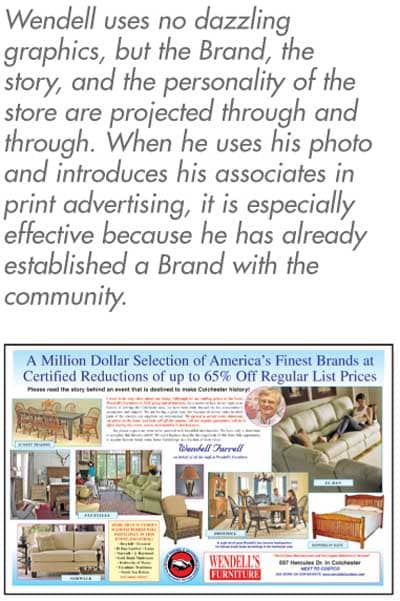
Whether you are a CEO, or in sales, or are a vendor, or a delivery person, or any other associate, you also have a personal Brand. It has been said that the salesperson is the store to the customer. This is true enough. In fact, every associate in the store is, by degree, the store. So is the delivery captain (more on that later), and to an even greater degree, the boss.
There are four principle factors that quickly project your Brand:
- How do I look?
- How do I sound?
- What do I say?
- How well do I listen?
An astonishing fifty-five percent of your Brand is communicated by facial expression and body language alone. Your voice—not including your words—may transmit as much as thirty-eight percent of your meaning in face-to-face communications. And your words (at least in the first minute or less) account for only seven percent of your communication. If you don’t like the way your associates are expressing the Brand of your company, there is a strong possibility they are modeling you. If not you, then they are modeling your managers, who in turn are likely modeling you.
In his book, The Irresistible Offer… How to Sell Your Product in Three Seconds or Less, Mark Joyner suggests that his own sales super-guru Brand requires several elements. (You can adjust these elements any way you want for your status as super furniture entrepreneur, or super sales person, or whatever):
- Impeccable grooming
- Friendly smile
- Confident posture
- Outgoing and kind nature
- “My spirit shining through”
- First words: Something disarming and friendly
Joyner adds this note: “Some people may read these words and want to vomit, and that’s OK. Cynical and sarcastic people may not like guys like me, and that’s cool. My [Brand] will sort right through them. I don’t want to be around them and they don’t want to be around me. No worries.”
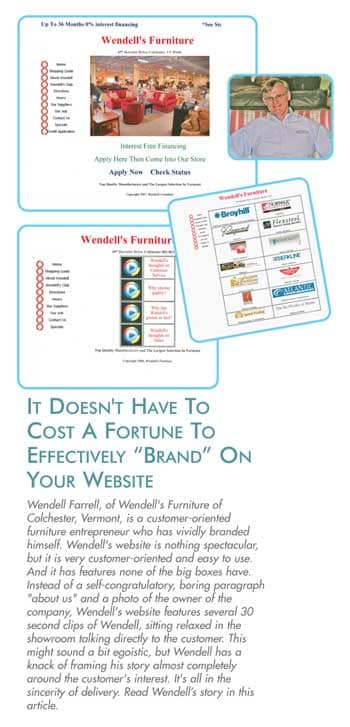
Since you are still reading, I will presume you find the list of qualities that Joyner recommends is at least worth considering. And, hopefully you buy into the premise that your character is the primary molder of your store’s Brand. You understand that the quality of your People Media™ begins with what you project to your associates, your customers, and your vendors. What are you communicating to your managers and associates? Integrity? Confidence? Grace and power? Caring? Or fear, annoyance and lack of confidence?
What next? The quality of your People Media is reflected in everything the customer encounters during the shopping experience. The shopping experience begins with the setting of their expectations (from advertising, a friend, pure luck, or your website). It continues through the appearance of your parking lot, showroom, bathrooms, your associates, and through the selling sequences.
Previous FURNITURE WORLD Magazine articles that have covered these topics in detail can be found in the furninfo.com website marketing article archives. The shopping experience, for most stores, ends with the delivery (unless there is a service or quality problem). It should not end there, but it usually does.
How to Bring Customers Back
I once interviewed over three hundred associates for a large furniture chain. It was a great education that really came alive while speaking with the delivery crews. I happened to meet an interesting delivery captain. When asked to describe his job, he responded by saying, “Look, I am the most important person in the sales process. I resell every customer on the purchase they made. I tell them how great it looks, and how they made a great selection that their family and friends will admire. There is never buyer’s remorse when I deliver something.”
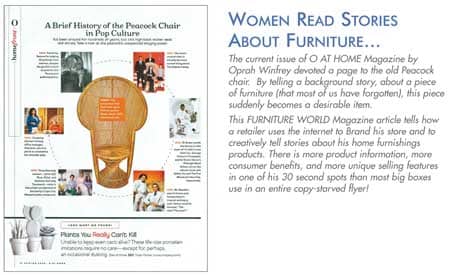
This beautifully arrogant statement stayed with me. My wife and I recently had a leather sectional delivered to our home in St. Augustine. The delivery captain did a great job. He demonstrated the piece, gave us hints on care, and left his card if anything else was needed. Now, my experience as a furniture customer was eye-opening. I got to thinking, what could be added to this delivery sequence, this exceptional People Media, that would make it even better?
First off, consider the formula created by Jay Abraham that was presented in the March/April 2008 issue of FURNITURE WORLD Magazine. Jay stated that there are three, and only three, ways to increase your business.
- Increase your number of customers.
- Increase the size of your tickets.
- Increase the number of times your customers visit your store.
Moreover, Jay claimed that a mere10% increase in each of these categories will double your volume. Here are some specific ways that will measurably increase your volume in two of these three categories. I’m sure you can brainstorm more improvements to the delivery sequence.
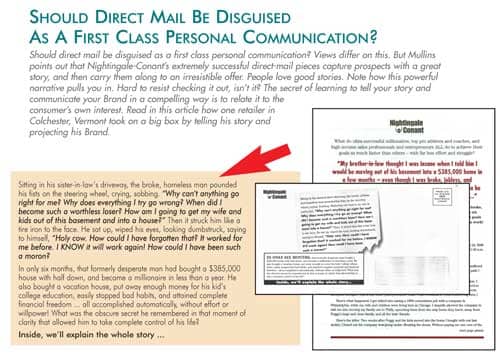
SUGGESTED SCENARIO: After placing the recliner or sofa in the right place and admiring how great it looks and stating what an excellent buy the customer has made (before thrusting the scary-looking paperwork at her), the delivery captain hands the customer a gift. This gift has three parts. First, it has a lovely thank you card from the salesperson. “Mrs. Smith, your sales adviser, Jane Consultant, asked me to be sure to pass this along to you.” Later, Mrs. Smith will learn that inside is a personal note from Jane Consultant thanking her for the purchase, and assuring Mrs. Smith that Jane will personally be glad to help if there is ever a need. Sales persons should look at any future contact with Mrs. Smith, not as an annoyance, but rather as another opportunity to exceed her expectations for quality and service.
Inside are a couple of cards from Jane Consultant, and a final little note along these lines: “The greatest honor you can give me is to recommend my services to a friend ...”
Next, the little gift pack contains a small brochure selling your store. Yes, you should have one by now. It is critical that such a “portable website” be handed to every guest who happens into your store. This silent salesperson tells your story and introduces your unique Brand in the best possible way. It makes sense to leave your prospects and customers with a reminder of how great you and your team are. Once the creative work is done, such a flyer is relatively inexpensive. Finally, consider placing other surprises in the “Come Back” package to wow your customer and exceed their expectations. Perhaps include a special coupon or an invitation to your next decorating seminar. This key element in building business has been covered in Margaret DeGange’s multi-part Decorating Crash Course series in FURNITURE WORLD Magazine, that is posted to the article archives area on www.furninfo.com. It would also be a nice touch if the delivery captain handed his card to the customer. Or, at least a card stating “Delivered with pride by ___________ and _________ of ________ Furniture.”
OK, it will be a lot of fuss to create and police a program like this. But, remember that it costs eight times more to get a new customer than to keep an old one. And, if this technique works only one out of ten times in getting a referral or bringing a customer back into your store, it will reach Abraham’s ten percent criterion for doubling your store’s business!
Will you do it?
I got a couple of responses from store owners who wanted to know if I was serious when I wrote that only one percent of people who read Jay Abraham’s book will follow his advice. The answer is yes. Only about one percent excel on world-class levels in any given field. To illustrate this, I pass along a little story. Mark Joyner is a top consultant-guru. He tells in his aforementioned book that he once gave a seminar to a few hundred people, and he asked this question: “How many of you have ever heard of Napoleon Hill’s book, Think and Grow Rich?” Almost everyone in the room stood up. “How many of you have read it?” Nearly everyone remained standing.
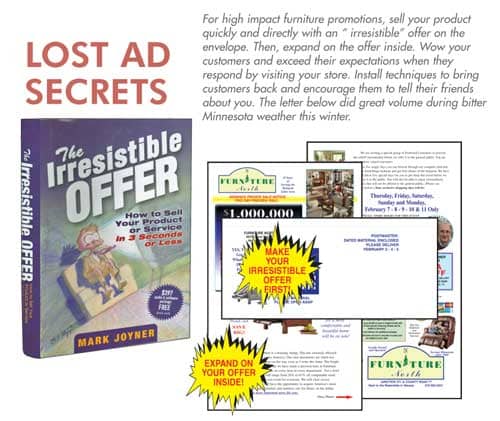
Joyner then said: “If any of you still standing don’t believe that following the principles in this book will make you rich and successful beyond your wildest dreams, I want you to sit down right now.” Everyone remained standing. Then Mark noted that on page 38 of the trade publication of Think and Grow Rich, Napoleon Hill suggests that—if you want to have success with his book and get rich—it is imperative to use his formula to craft a brief personal statement, commit it to memory, and repeat it twice daily until the dough comes rolling in. Joyner then said that since everyone still standing believes in the book, surely someone will come up on the stage and recite their success statement. He said everyone else should sit down. You probably guessed it. Everyone sat down.
One percent of furniture entrepreneurs and salespeople are shakers and movers and only a few successful independents will at least seriously consider the delivery sequence advice suggested earlier. One in particular comes to mind. His story, coming from the front lines of the furniture industry, is worth ten articles by ivory tower experts. Wendell Farrell, of Wendell’s Furniture of Colchester, Vermont, is a customer-oriented furniture entrepreneur. He has vividly branded himself. A natural at projecting good People Media, Wendell Furniture is one of the few furniture stores that had a good year last year. And Wendell grew his business in the face of a famous Big Box competitor. In fact, he helped compel them to close their doors after a short run and leave town! How did Wendell do it? Read on.
Who’s afraid of the Big Bad Box?
When a big box came to Colchester in 2005, it frightened many stores on furniture row. And it hurt them all at first with great looks, low prices and huge ad budgets. It seemed as though nothing could stop the big box. Meanwhile, away from furniture row, Wendell ignored the big box, and kept plusing his own brand. “Plusing” is a term Walt Disney used to indicate taking a good concept idea and adding to it to make it better. Wendell’s did not try to outgun the big box. He carried his traditional lines and stuck to them. Before very long the big box was fading, and eventually, unceremoniously closed its doors.
So what is so great about how Wendell advertises his Brand? It’s all about the customer. When a customer calls Wendell’s on the phone, Wendell Farrell himself is as likely to answer as anyone ... “Good afternoon, this is Wendell. How may I help you?” Well thought out and practiced phone etiquette is an important, yet often ignored aspect of furniture store brand-building. Associates need to be supplied with a script to do it right. Something along the lines of , “Good afternoon, (store name), this is Jane Smith. How may I help you?” Or, “Good afternoon (store name), How may I help you? This is Jane Smith.” Research has shown that customers will remember a person’s name if it is stated last. The benefit of this technique is that the customer will often start their reply by restating the Associates name, putting the ensuing conversation on a more personal basis. So often Associates simply grumble the store name, whatever it may be. Not only does Wendell often answer the phone, he loves to wait on customers. According to Britt Beemer of America’s Research Group, people feel honored when the owner of a store waits on them. Wendell’s associates are all salaried, so there is no friction when Wendell takes an UP. Wendell will even make you a cup of fresh down-home coffee in the store’s kitchen. Did I say store’s kitchen? Yes. For more information on the power of the imagery of the home to American consumers, review the FURNITURE WORLD Magazine article, “The Code That Unlocks Customer’s Hearts & Wallets” (Parts 1&2) that is posted to the marketing management article archives on the www.furninfo.com website.
These are simple and inexpensive techniques that any furniture store can do in its own way. Let’s look at Wendell’s website, for example. It was set up by a member of Wendell’s staff, Mike Prevuzmak. Nothing spectacular. But it is very customer-oriented and easy to use. And it has features none of the big boxes have. Instead of a self-congratulatory, boring paragraph “about us” (that no one ever reads) and a photo of the owner of the company, Wendell’s website features several 30 second clips of Wendell, sitting relaxed in the showroom talking directly to the customer. This might sound a bit egoistic, but Wendell has a knack of framing his story almost completely around the customer’s interest. It’s all in the sincerity of delivery. Here is a sample script:
“Here at Wendell’s Furniture we really, really value the customer. The sales help is phenomenal. They treat everybody the same, everyone gets taken care of. No one is on commission at Wendell’s, talk to anybody in a blue shirt. Everybody takes care of you, everybody makes deals. We do not allow any customer to be unhappy. Here at Wendell’s Furniture, we take care of you.” (Super-imposed over the screen are the words: “Your total satisfaction is our main priority.”)
Another good spot features Wendell walking casually in the showroom … “High folks, it’s Flexsteel authorized sale time. This is the big one…” (Cut to Wendell on his knees by a sofa. He has a marking pen in his hand.) “This is the newest in Microfiber technology and only Flexsteel has it” (Wendell is touching the arm of the sofa as he says this.) (Cut to close up of Wendell’s hand holding the marking pen. He marks several swipes on the sofa arm.) “See the ink?” (Rubbing it off) Now the ink has gone – with just a Handy Wipe.” (Cut to Wendell kneeling beside a leather recliner) “Just feel the quality of this leather on this Flexsteel Recliner.” (Cut to Wendell kneeling beside an occasional chair) “Why buy Flexsteel?” (Wendell flips the chair over exposing the springs. He reaches in and grabs one, pulling on it) “It’s just about indestructible. You can’t wear it out, and you can’t break it.” (Cut to full showroom, large Super with sig: “15% TO 20% OFF FLEXSTEEL FACTORY AUTHORIZED SALE”) “At 15 to 20% savings, this is the time to purchase your beautiful Flexsteel furniture, exclusively at Wendell’s Furniture” (Cut to outside store shot with address and phone supped over.)
There is more product information, more consumer benefits, and more unique selling features in this 30-second commercial than most big boxes use in an entire copy-starved flyer! Yet there is nothing difficult to execute and nothing spectacular. This is the kind of Branding that you can adapt and start doing now.
The big boxes are too busy being big to let the human side of their story and their desire to serve show through. I should emphasize again, though: Wendell’s delivery in his commercials is exceptional. His sincerity, and his Brand, shine through in how he talks, his body language and in his appearance in the ubiquitous Wendell’s “blue shirt.” It is worth a trip to wendellsfurniture.com to see him do his thing.
There’s more. Wendell has a “Shopping Guide” tab. If you open it, you are able to access general information about buying furniture and mattresses. (This one could be improved with a couple of additional streams or clips featuring Wendell.) Also, you can click on “Our Suppliers” (Better would be “Our Famous Brands”) and immediately access the websites of Wendell’s key brands, such as Flexsteel, el ran, Berkline, Benchcraft, etc. Berkline has an excellent site, by the way, with an optional virtual human being “guide.” Benchcraft had one too. But, I wonder why these huge companies can’t use the CEO to deliver some kind of a short personal message to the consumer in the Wendell fashion? Using only slick pros and carefully crafted scripts dampen the authenticity of the presentation. Wendell uses no dazzling graphics, etc., but the Brand, the story, and the personality of the store are projected through and through. When Wendell uses his photo and introduces his associates in print advertising, it is especially effective because he has already established a Brand with the community.
There are weaknesses in the site, I know. I could nitpick. But compared to what the big boxes do, this one connects. It is real, believable, and human. Not so with the big boxes. One big box, claiming to be mattress experts, shows nothing but sizes and prices. No personal connection, no benefits, no unique selling propositions, no arresting concepts about the expertise of the associates or ease of selection (the mass of tiny mattress illustrations and prices are overwhelming). Moreover, the assurance of satisfaction has almost as much small print as a real estate contract.
Direct Mail Offers
I regret that there is no more space to spend with you this month. But I have one more thing to tell you. Someone wrote me and asked if you should try to disguise a direct mail piece to make it look like a personal first class mail letter from a friend. The argument is that more people will open the letter.
True enough, but that’s as far as it goes, the next stop will be the trash can. Among the top direct marketers I know are the Nightingale-Conant folks. Check out the exhibit in this article, and note how their direct-appeal drags you into the letter.
For high impact furniture promotions, I suggest you adopt this technique I use for direct mail: Sell your product quickly and directly with an “ irresistible” offer on the envelope. Then, expand on the offer inside. Wow your customers and exceed their expectations when they respond and come to your store. Establish and practice techniques to bring customers back and encourage them to tell their friends about you.
Yes, I am aware you don’t have time for all of this. So, develop a team of a few young lions to work with you and pursue these ideas. What incentive do they have? They get to learn something valuable. Young people today are motivated by training, learning something that will give them an edge. Reward some aspiring person with an eye of the tiger to study copywriting by getting some of the great advertising books for them or paying for his or her writing course. Time spent training and brainstorming your Brand is not down time, it will repay you many times over. Most of all: Don’t just talk about your Brand, begin to LIVE your Brand. I look forward to our next visit.
Contributing Editor Larry Mullins has 30+ years experience in the front lines of furniture marketing. Over the past ten years he has developed a Visionary Management program that can impact the culture of an entire organization and bring it to life. He also produces state-of- the-art promotional advertising packages for everything from quick cash flow to complete exit strategies and store closings. Larry is the President of UltraSales, Inc.. Questions about this article can be sent to Larry care of FURNITURE WORLD to mullins@furninfo.com.
See more articles by Larry in the marketing management archives on furninfo.com